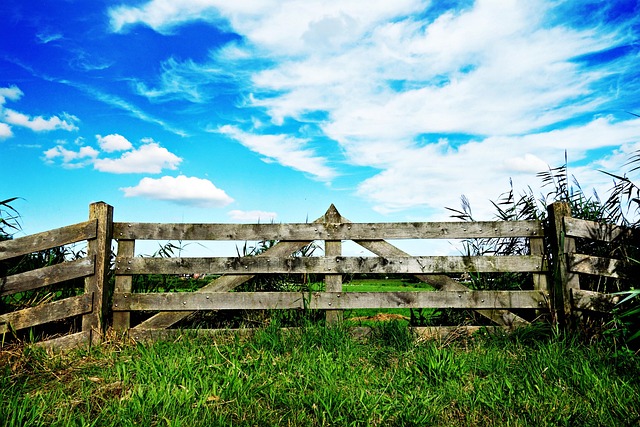In coastal regions, where harsh weather conditions and salty air pose unique challenges, selecting the right fencing material is paramount. This article explores durable wooden fencing as a robust and aesthetically pleasing solution for your coastline property. We delve into the specific challenges of coastal fencing, highlighting the benefits of wood in withstanding salt spray and strong winds. By understanding the key considerations, from choosing the right wood species to installation and maintenance tips, you’ll discover how to enhance both functionality and natural beauty along your shorefront.
- Understanding Coastal Fencing Challenges
- Benefits of Durable Wooden Fencing
- Choosing the Right Wood Species
- Installation and Maintenance Tips
- Enhancing Coastal Aesthetics with Custom Designs
Understanding Coastal Fencing Challenges
Coastal areas present unique challenges when it comes to fencing due to harsh weather conditions, including high winds, salt mist, and frequent storms. Traditional fencing materials may not withstand these elements, leading to frequent repairs or replacements. The challenge is to find a durable solution that can protect properties while withstanding the relentless coastal environment.
Wooden fencing, when properly treated, offers an attractive and natural solution for coastal areas. Durable, rot-resistant wood species such as cedar or treated pine are ideal choices. These woods have inherent resistance to moisture and insects, which is essential for preventing damage in salty environments. Additionally, the right coatings or finishes can further enhance their durability, ensuring that the fencing remains strong and aesthetically pleasing for years to come.
Benefits of Durable Wooden Fencing
Durable wooden fencing offers an array of advantages for coastal areas. Firstly, it provides a natural and aesthetically pleasing barrier that can complement the surrounding landscape. Unlike synthetic materials, wood adds warmth and character to the environment, creating a more welcoming atmosphere. Secondly, durable wooden fencing is highly versatile and can be custom-designed to fit various shapes and sizes, ensuring it seamlessly blends with the coastal terrain.
Moreover, this type of fencing is an environmentally friendly option. Wood is a renewable resource that can be sustainably managed, making it an eco-conscious choice for homeowners and businesses alike. Additionally, its natural resistance to rot and decay reduces the need for frequent replacements, providing long-term cost savings. The durability of these fences also means they can withstand harsh coastal conditions, including strong winds and salty air, ensuring a robust and long-lasting solution.
Choosing the Right Wood Species
When selecting wood for coastal fencing, understanding the local climate is key. Saltwater exposure and fluctuating moisture levels can take a toll on any material, but certain tree species are more resilient than others. Hardwoods like cedar, redwood, and teak are popular choices due to their natural resistance to rot and insects. These woods also have a beautiful, durable finish that stands up well to coastal conditions.
Considered a premium option, these hardwoods can be more expensive but offer long-lasting protection against the elements. Their dense structure prevents water absorption, minimizing the risk of warping or splitting. Additionally, their natural oils repel moisture and UV rays, ensuring the fence remains vibrant and strong for years to come.
Installation and Maintenance Tips
When installing durable wooden fencing in coastal areas, it’s essential to ensure proper drainage to prevent water damage. The terrain should be prepared with a slope or gradient that allows for effective water run-off. Digging shallow trenches around the fence posts and filling them with gravel can help improve drainage. Additionally, consider using treated timber or metal brackets to support the fence, as these materials are more resistant to corrosion from salty air and moisture.
Regular maintenance is crucial for prolonging the life of your wooden coastal fence. This includes routine cleaning to remove salt deposits and debris, as well as re-staining or painting to protect the wood from UV damage and weather exposure. Inspect the fence regularly for signs of rot, insect infestation, or structural damage and address these issues promptly with appropriate repairs or replacements. Keeping the area around the fence free from overhanging branches and other obstacles will also help maintain its integrity and appearance.
Enhancing Coastal Aesthetics with Custom Designs
Coastal areas often boast stunning natural landscapes, and durable wooden fencing can be a beautiful way to enhance this unique aesthetic. By incorporating custom designs, property owners can create fences that not only serve as practical boundaries but also become iconic features of their coastal homes. These designs can draw inspiration from the surrounding environment, such as incorporating sea-inspired motifs or mimicking the organic shapes found in nearby beaches and cliffs.
Custom wooden fencing allows for intricate carvings, elegant curves, and unique patterns, ensuring every fence is a work of art. Skilled craftsmen can bring these designs to life using locally sourced wood treated to withstand the harsh coastal climate. Such fences not only add visual appeal but also provide a sense of seamless integration between the built environment and the natural beauty of the coast.
